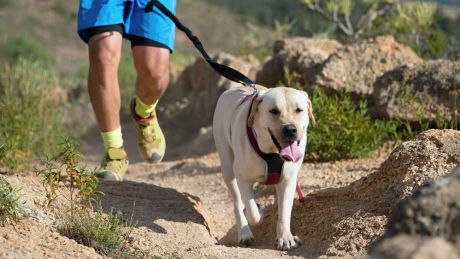Canicross: How To Start Cross-Country Running With Your Dog
We’ve teamed up with pet insurance provider Petplan to introduce you to a sport every dog owner should know about

A good running buddy makes the miles fly by, and with canicross you get the best running buddy of all – your dog. Canicross is a sport that will make both you and your four-legged friend fitter and healthier while you experience the great outdoors, and it also challenges your dog’s wits as they follow directions while running. In short, it’s a sport all dog owners should consider trying! Here’s everything you need to know to get started.
What is canicross?
Canicross is cross-country running with your dog. Or, to be more accurate, it’s cross-country running while your dog pulls you along via a harness and you shout directions, dog-sledding style. The running is done off-road rather than on paved surfaces because it is easier on the dog’s paws. And your paws, for that matter.
Can any dog take part in canicross?
As long as your dog is healthy, any breed can take part in canicross, but some are better suited to it than others. Herding and hunting dogs like Border Collies and Labrador Retrievers are especially good, as are sled dogs like Huskies, because they are accustomed to taking directions and covering long distances. Needless to say, smaller dogs provide less pull and can’t run as fast or as far. It’s also not a sport for puppies. Your pooch should be at least a year old – and over 18 months old if you are running distances of ten miles and above.
What do I need?
The first thing to do is check with your vet that your dog is fit enough to try canicross. Making sure they are happy and healthy is vital, and if they aren’t already insured you should also consider getting Petplan pet insurance. It’s not a dangerous sport, but pulling you along cross-country courses is obviously more demanding for a dog than short walks around the block.
Then it’s time to buy the key bit of canicross kit – the harness. It needs to be comfortable for both dog and owner, so make sure it isn’t too tight on your pooch and that they don’t have any trouble breathing. Listen out for wheezing and watch their movement to see if they are restricted in any way. The harness fits around the dog’s shoulders and it should have a bungee cord to reduce the shock of sharp pulls.
On your end, you need a waist belt to attach to the lead so your hands are free for running. Your belt will ideally have legs straps for a more secure fit and to reduce any strain that could be put on your back, which is particularly important if you have a bigger dog that pulls hard. It’s also worth investing in a pair of trail-running shoes to ensure you have the grip to run off-road, as well as some lightweight running clothes.
After that, it’s all about finding your closest event and training your dog to follow directions. We recommend that the first thing you do is teach them the calls for “slow down” and “stop”.
Petplan is the UK’s most trusted pet insurer, offering policies to help keep pets healthy for the rest of their lives. If your pet isn’t insured, take out pet insurance by Petplan now.
Get the Coach Newsletter
Sign up for workout ideas, training advice, reviews of the latest gear and more.

Nick Harris-Fry is a journalist who has been covering health and fitness since 2015. Nick is an avid runner, covering 70-110km a week, which gives him ample opportunity to test a wide range of running shoes and running gear. He is also the chief tester for fitness trackers and running watches, treadmills and exercise bikes, and workout headphones.
